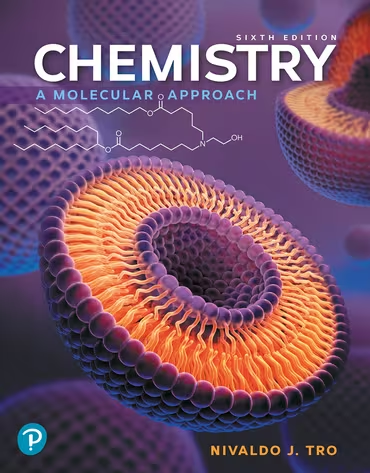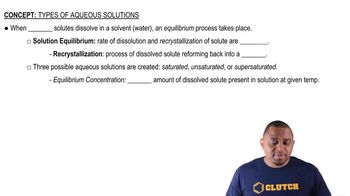Use the data to calculate the heats of hydration of lithium chloride and sodium chloride. Which of the two cations, lithium or sodium, has stronger ion–dipole interactions with water? Why?
Ch.14 - Solutions

Chapter 14, Problem 45
A solution contains 35 g of NaCl per 100.0 g of water at 25°C. Is the solution unsaturated, saturated, or supersaturated? (Use Figure 14.11.)
 Verified step by step guidance
Verified step by step guidance1
Identify the solubility of NaCl in water at 25°C from Figure 14.11. This figure typically provides the maximum amount of solute that can dissolve in a given amount of solvent at a specific temperature.
Compare the given amount of NaCl (35 g) to the solubility value obtained from the figure for 100.0 g of water at 25°C.
If the given amount of NaCl is less than the solubility value, the solution is unsaturated, meaning more solute can dissolve.
If the given amount of NaCl is equal to the solubility value, the solution is saturated, meaning it contains the maximum amount of solute that can dissolve at that temperature.
If the given amount of NaCl is greater than the solubility value, the solution is supersaturated, meaning it contains more solute than can typically dissolve at that temperature, often requiring special conditions to maintain.

Verified video answer for a similar problem:
This video solution was recommended by our tutors as helpful for the problem above.
Video duration:
1mWas this helpful?
Key Concepts
Here are the essential concepts you must grasp in order to answer the question correctly.
Solubility
Solubility is the maximum amount of a solute that can dissolve in a specific amount of solvent at a given temperature. For NaCl in water at 25°C, the solubility is approximately 36 g per 100 g of water. Understanding solubility helps determine whether a solution can hold more solute or if it has reached its limit.
Recommended video:
Guided course

Solubility Rules
Saturated Solution
A saturated solution is one in which the maximum amount of solute has been dissolved in the solvent at a specific temperature. In this case, if the solution contains 35 g of NaCl in 100 g of water, it is close to saturation but not quite there, indicating that it can still dissolve more solute before reaching saturation.
Recommended video:
Guided course

Types of Aqueous Solutions
Supersaturation
Supersaturation occurs when a solution contains more solute than it can theoretically hold at a given temperature, often achieved through heating and then cooling the solution. In this scenario, since the solution has 35 g of NaCl, which is less than the solubility limit, it cannot be classified as supersaturated.
Recommended video:
Guided course

Types of Aqueous Solution Example
Related Practice
Textbook Question
Textbook Question
Potassium nitrate has a lattice energy of -163.8 kcal/mol and a heat of hydration of -155.5 kcal/mol. How much potassium nitrate has to dissolve in water to absorb 1.00⨉102 kJ of heat?
Textbook Question
A KNO3 solution containing 35 g of KNO3 per 100.0 g of water is cooled from 40°C to 0°C. What happens during cooling? (Use Figure 14.11.)
Textbook Question
A KNO3 solution containing 35 g of KNO3 per 100.0 g of water is cooled from 40 °C to 0 °C. What happens during cooling? (Use Figure 14.11.)
Textbook Question
A KCl solution containing 38 g of KCl per 100.0 g of water is cooled from 60 °C to 0 °C. What happens during cooling? (Use Figure 14.11.)
